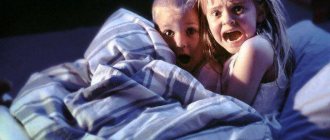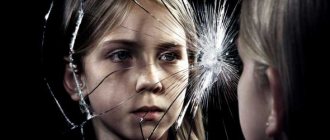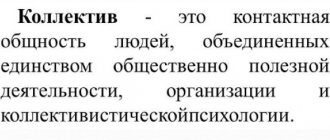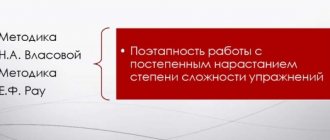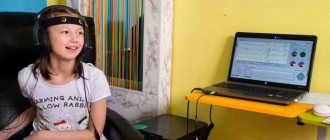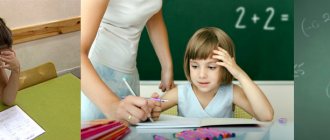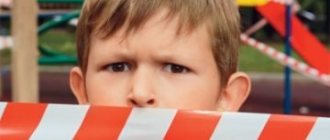Alalia in children is a systemic disease characterized by profound impairment of speech function, insufficient degree of its development or complete absence.
Alalia in children is a systemic disease characterized by profound impairment of speech function, insufficient degree of its development or complete absence. In this case, the patient’s hearing is not impaired, a decrease in the intellectual level is not initially observed and may be of a secondary nature.
Alalia must be differentiated from aphasia. With aphasia, the child loses speech function, but previously speech was present. With alalia, expressive or impressive speech is absent or significantly limited initially. This disorder is detected in approximately every hundredth child under 6-7 years of age; in older children it is diagnosed extremely rarely. Moreover, the pathology is detected in boys twice as often as in girls.
Alalia in children - classification of the disease:
- Sensory alalia - this form of pathology is characterized by the fact that the patient has physical hearing, but due to damage to a certain part of the brain, the speech of people is not understandable for the child.
- Motor alalia - this type of pathology is characterized by the lack of development of one’s own speech function. But the speech of other people is understandable to the child.
- Sensorimotor alalia is a mixed form of pathology with a predominance of the first or second type of disorder.
Alalia in children is diagnosed with the involvement of a wide range of specialists. These are, in particular, a neurologist, otolaryngologist, speech therapist and psychologist. All doctors should specialize in the specific characteristics of childhood diseases. During the diagnostic process, the pathology is differentiated from hearing loss, autism and some other disorders. The following methods are used for this:
- Electroencephalogram (EEG) of the brain.
- Echoencephalography.
- Diagnostics of oral speech, auditory-verbal memory, auditory function.
- Magnetic resonance imaging of the brain.
Early diagnosis of pathology is the key to successful treatment, or more precisely, correction of the disease. If a disorder is detected at 3 or 4 years of age, doctors give a favorable prognosis.
Clinic, symptoms of motor alalia
How does alalia manifest, what is the clinical picture of this disease? Symptoms of motor alalia : errors in the pronunciation of sounds, isolated onomatopoeia, omissions, distortion, mixing sounds, paraphrase, replacement of sounds, small volume of vocabulary, speaks very few words, specific agrammatisms, difficulty memorizing a visual image, gross errors in word formation and inflection, stereotyping, rude delayed speech development, exclamations, difficulties in composing sentences or stories, babbling words, impaired verbal logical thinking, psychopathological changes, memory impairment, tearfulness, impulsiveness, disinhibition, shyness, difficulty in upbringing.
Causes of alalia
Different factors contribute to the occurrence of speech disorders at different stages of life. So, in the antenatal period:
- fetal hypoxia;
- toxicosis;
- injury to the fetus due to falls or bruises of the mother;
- intrauterine infections and inflammations;
- threats of miscarriage;
- metabolic disorders during intrauterine development;
- maternal diseases of a chronic nature (heart and pulmonary failure, hypertension, etc.).
In the perinatal period:
- difficult or pathological childbirth;
- asphyxia, hypoxia of the newborn and intracranial birth injury;
- use of obstetric devices.
In the first years of life:
- brain injuries;
- inflammatory processes of the brain;
- diseases that cause depletion of the nervous system;
- frequent or prolonged somatic diseases.
In addition to biological factors, the condition is aggravated by unfavorable social conditions of the child’s development: pedagogical neglect, lack of verbal contact or its rarity. As a rule, with alalia there is not one reason that provokes an increase in the defect, but a whole complex that leads to brain dysfunction.
Sensory alalia, characteristics, speech symptoms
Sensory alalia is a violation of speech understanding, as a result of which the child’s own speech is secondarily underdeveloped. Such children are called sensory alaliki ( children with sensory alalia ). Initial impressions of sensory alalik make one think of either mental retardation or early severe hearing loss. Contact with such children is very difficult. To attract their attention, it is necessary not only sound influence, but also tactile influence, as well as being in the field of vision of such a child.
Symptoms and signs of alalia.
Symptoms primarily depend on the type of alalia. Motor alalia has characteristic symptoms: poor development of hand movements; poor coordination; poor performance; speech can only appear by age 4; inability to express one's thoughts in words; replacing some words with others; incorrectly constructed sentences; reluctance to talk; touchiness, isolation, aggressiveness. Sensory alalia has characteristic symptoms: impaired speech perception; repeating words after someone; isolation; changing letters in words; merging several words into one; impulsiveness, increased activity, but at the same time the child may be withdrawn or depressed by something; lack of connection between an object and the word that denotes it.
FORMS OF ALALIA:
Pediatric neurologists and reflexotherapists distinguish 2 main forms of alalia: motor alalia, sensory alalia.
How to treat alalia, get rid of alalia, how to treat motor and sensory alalia?
Sarklinik knows how to treat alalia , how to cure speech underdevelopment, alalia in children of early, preschool, school age, how to get rid of alalia in Saratov! An experienced doctor will tell you a way out of severe alalia ! Effective treatment methods have helped many of our patients get rid of alalia. Effective treatment of alalia , classes give excellent results, develop cognitive activity, form sound and morphological analysis, and restore the semantic aspects of speech. Special reflexology techniques activate the speech centers of the brain Wernicke and Broca, associative speech zones, which improves speech understanding, sound pronunciation and diction, and increases vocabulary.
On the website sarclinic.ru you can see a doctor for free and get a short answer on the treatment of alalia.
At your first consultation at the sarclinic, you can receive information on the treatment of alalia disease and the following questions. What is expressive alalia in children? Is speech therapy work necessary for alalia (speech therapist, speech therapy)? What is psychological optical sensorimotor (sensorimotor) alalia? Why is afferent expressive or expressive alalia dangerous? What are the characteristics and prognosis of children with speech disorders and disorders? What is aphasia, ondr, dysarthria, autism, dyslalia?
Information about treatment at Sarklinik:
Reviews
Treatment of developmental delay in children.
What to do if the child does not speak?
Therapy for mental retardation
ZRR and ZPRR
Sign up for a consultation. There are contraindications. Specialist consultation is required.
Photo: Stephaniefrey | Dreamstime.com\Dreamstock.ru. The people depicted in the photo are models, do not suffer from the diseases described and/or all similarities are excluded.
Related posts:
Bruxism, teeth grinding during sleep, odonterism: symptoms and treatment
ADHD in children: treatment, attention deficit hyperactivity disorder
Intracranial hypertension syndrome, liquorodynamic disorders
Vegetative vascular dystonia in children, treatment of VSD in Saratov
Dyslexia, treatment of dyslexia, correction, overcoming, elimination, alexia, treatment of alexia
Comments ()
Types of alalia
Alalia can be expressed in different forms, each of which has its own characteristics depending on the defect and specific manifestations:
- Expressive (motor) alalia is diagnosed when there is an organic lesion in the speech motor analyzer section. Characterized by a delay in the development of speech function or its stop at any stage, while the understanding of the words of others does not suffer. With this type of alalia, the child has difficulties in expressive speech, grammar, and a poor vocabulary. Depending on which area was affected, subspecies are distinguished:
- afferent - appears if the lower parietal parts of the brain are affected, the method of manifestation is incorrect or difficult articulation;
- efferent - characteristic of damage to the premotor cortex, which leads to disruption of the syllabic structure of words.
- Impressive (sensory) alalia - appears after lesions of the speech-hearing analyzer. Disturbances in the perception of sound are characteristic when the auditory analyzer is healthy (the child does not understand the meaning of the words addressed to him). It looks like a gap between the meaning and sound of words.
- Mixed (sensorimotor) alalia - occurs with a combination of organic disorders of the auditory and motor areas. The severity of the defect in these areas can be different, that is, motor defects can be severe, and sensory ones can be mild, or vice versa. It is precisely because of the multiplicity of options and combined symptoms that this type of alalia is considered the most severe speech defect, both from the point of view of diagnosis and correction.
A pure type of speech disorder is quite rare. The most common form of alalia is mixed, with a predominance of one direction. In addition, determining the type of alalia is complicated by the fact that the symptoms overlap with indicators of other disorders or are accompanied by intellectual and emotional deviations.
Prevention of alalia
A young mother should take care of the health of her baby even before his birth. It has been proven that pathology can affect the cerebral cortex of children even at the stage of intrauterine development. It is important for a pregnant woman to strictly follow all the recommendations of the gynecologist, to be extremely careful, to avoid falls and injury to the fetus.
Be sure to follow the following medical advice to protect your child as much as possible from a dangerous illness.
- During pregnancy, regularly visit doctors, conduct examinations, and take all necessary tests.
- Take care of your health and take care of the well-being and harmonious development of your baby.
- If a doctor prescribes additional vitamins and medications for a pregnant woman, his advice must be followed strictly.
- Labor must begin exactly on time. If there is a significant delay, you need to insist on drug induction of labor.
After the birth of the baby, you need to create the most comfortable and favorable conditions for its harmonious development. If you strictly follow all the above rules, you will have no reason to worry about your baby’s health.
Diagnosing alalia at an early stage will make the treatment of the pathology as effective as possible. That is why parents should closely monitor the development of speech in their child, and immediately consult a doctor if they detect the slightest deviation from the norm. A child can get rid of a sensory type of illness much faster than a motor type. If doctors in a regular clinic cannot determine the exact cause of improper speech development in a child, contact a paid private clinic. Most often, such medical institutions have innovative equipment for diagnosing alalia. There is no need to try to save your time and money if you want your baby to grow up to be a full-fledged individual.
How to help a child with alalia
Despite the fact that speech impairment in this case is associated with damage to certain areas of the brain, corrective measures may well improve the situation. The most important thing is not to wait for the weather “by the sea”, hoping that the situation will form itself.
The fact is that with alalia a rather extensive disorder occurs, in which the brain is not able to compensate for it itself. Correction of alalia should be comprehensive with a combination of medication and psychological and pedagogical measures. If necessary, the neurologist prescribes medications that help stimulate the maturation of brain functions. In addition, physiotherapeutic procedures are indicated for alalik children.
Speech pathologists and speech pathologists undoubtedly take on the main role in working to correct this condition. They are the ones who have the most difficult task - teaching a child to speak.
Classes with a defectologist are structured with mandatory consideration of the child’s individual condition and the level of speech underdevelopment. During the correction, work is carried out on:
- Formation of a conceptual apparatus.
- Expansion of active and passive vocabulary.
- Improving sound pronunciation.
- Development of general and fine motor skills.
- Correct word formation and the formation of coherent speech.
- Development of auditory attention and phonemic speech. Read more about phonemic speech underdevelopment.
- Cultivating sustainable attention, developing memory and thinking.
Causes of sensory alalia in children
Sensory alalia is associated with damage to those areas of the brain that respond to the analysis of sounds and speech. To be more precise, the posterior third of the left hemisphere: it is projected onto the area behind the ear.
The disease is caused by:
- Pathology during pregnancy - intrauterine hypoxia, infections, immune attack, drug use, bad habits, harmful working conditions, intoxication;
- Damage to the central nervous system during childbirth: rapid labor, narrow pelvis, obstetric care. The consequence is traumatic brain injury. And protracted labor, entanglement of the umbilical cord, oligohydramnios, premature loss of water causes damage to brain cells due to insufficient oxygen supply - hypoxia;
- Pathology in the postpartum period and the first years of life - injuries, space-occupying formations, inflammatory and infectious diseases of the brain and meninges, intoxication, toxic damage to brain cells due to infectious diseases.
Most often, several factors influence a child. The cortical part of the auditory-speech analyzer is affected, and the process of recognizing sound stimuli is disrupted. The child hears speech, but cannot grasp its meaning and content. That is, he has not developed phonemic processes and does not have the skill of holistic speech perception.
As a result, the excitation (impulse) is not transmitted along the chain to other analyzers: speech-visual, speech-motor. Thus, the baby hears speech, but cannot perceive it, analyze it, and therefore does not react to it in any way.
Article on the topic: “Diagnostics and correction of sensory alalia”
Diagnosis
and correction
of sensory alalia
Zhnechkova
Katerina Aleksandrovna
3rd year student of the Faculty of Psychology and Pedagogy
NSPU im. Minina, Russia, Nizhny Novgorod
Email:
Zhnechkova Katerina Alexandrovna
3-year student of the Faculty of Psychology and Pedagogy
Kozma Minin Nizhny Novgorod State Pedagogical University,
Russia, Nizhny Novgorod
Email:
Annotation.
The article discusses the issues of diagnosis and correction of sensory alalia from different points of view. The problems of differential diagnosis and modern approaches to solving these issues are considered. The article as a whole is in the nature of a generalization of theoretical material.
Annotation
.
The article deals with diagnostics and correction of sensory alalia from different points of view. The problems of differential diagnosis, modern approaches to these problems are considered. The article as a whole is a generalization of theoretical material.
Keywords:
sensory alalia, alalia diagnosis, alalia correction
Keywords:
sensory alalia, diagnostics of alalia, correction of alalia
In recent decades, there has been a clear trend toward an increase in the number of children with severe speech underdevelopment, manifested in various clinical forms (E.F. Arkhipova, G.A. Vanyukhina, etc.). Alalia is a systemic speech pathology. This means that if one of the links of the functional system falls out, the process of its formation as a whole is disrupted. According to neurologist O.I. Efimov, the number of children with alalia is approximately 8% of the total population of preschoolers. The issue of studying the structure of the defect, mechanisms of compensation and correction of alalia was raised in many studies from the middle of the last century (R. E. Levina, V. K. Orfinskaya, O. N. Usanova, S. N. Shakhovskaya, E. M. Mastyukova, G. V. Gurovets, N.N. Traugott, E.F. Sobotovich, etc.). Over time, the problem has not lost its significance (V.A. Kovshikov, T.G. Vizel, A.L. Bitova, etc.).
There are many more children with motor alalia than sensory alalia, hence the problems of differentiating this speech disorder from other disorders, as well as finding and improving corrective approaches and technologies to help overcome it. Improving differential diagnosis is very important nowadays. After all, a child can be damaged by an irreparable defect if he is sent to an institution that does not correspond to the true nature of his defect. This is how children with sensory alalia end up in schools for deaf children and do not receive adequate correction of their speech pathology.
Thus, such aspects as diagnosis and correction, their obvious relationship and timeliness are very relevant for children with sensory alalia.
Diagnosis of sensory alalia
The issue of improving the approach to recognizing, assessing and distinguishing the symptomatology of speech disorders in children remains relevant. After all, a child can suffer an irreparable defect if he is sent to an institution that does not correspond to the true nature of his defect. The complex structure of speech activity, the diverse connections of its components and their components with a wide variety of mental processes determine its sensitivity to the slightest deviations in the intellectual, analytical and motivational spheres. That is why, in one form or another, speech deviations are observed in a wide variety of mental development anomalies, which creates objective difficulties in recognizing and correctly assessing the manifestations of speech pathology in children.
A child with alalia can be confused with a child who is deaf and hard of hearing, a child with aphasia, mental retardation, or an autistic child. But a child with sensory alalia is more difficult to distinguish from a child with hearing loss. This is the description of a child with sensory alalia that can be found in the work of R.E. Levina “Experience in studying non-speaking children (alaliks)”:
“These children knew how to use only a few babbling fragments of words, accompanying them with explanatory gestures. They had sufficient mental development, a normal articulatory apparatus and full hearing. At the same time, children exhibited a specific immunity to the sounds of human speech, with intact hearing for all other sound impressions. This deficiency was expressed in a reduced ability to isolate the sound of phonemes from surrounding speech, the inability to distinguish phonemes (d-t, b-p). The impairment of clear differentiation of speech sounds was manifested in these children in the inability to analyze a word into its constituent phonemes. Access to surrounding speech is possible for them, mainly, through the capture of general, undifferentiated contour impressions of perception, stressed parts of words, and intonation of speech. The sound of such children's own speech fully corresponds to their undifferentiated perception. The understanding of speech in children suffering from impaired auditory perception turns out to be devoid of clarity; they confuse words that differ only in one or two phonemes, words with a similar sound and uniform stress; do not understand speech at all, delivered at a slightly accelerated pace; read aloud poorly. Only within the limits of habitual, everyday communication, provided that those around them speak clearly, measuredly, is it possible for these children to understand speech. Violation of the differentiated perception of speech sounds has a particularly difficult impact on their learning to write. Global, undifferentiated sounds, which help in oral communication, cease to be useful for the child during the transition to literacy. Mastering literacy requires clear isolation of each individual phoneme from surrounding speech, the ability to accurately analyze the sound composition of a word, i.e. precisely those processes that are impaired in children with defective auditory perception. Therefore, mastering writing is extremely difficult for them. They do not master literacy for a long time, and after they have overcome the rudiments of literacy with difficulty, the writing of such children remains defective, replete with specific errors. The origin of these difficulties is associated in these cases with a reduced ability to distinguish speech sounds and grasp phonemic relationships between them. Along with the noted features, a number of deviations in learning are observed, namely, insufficiently developed meanings of words, agrammatism, amnestic phenomena, paraphasia, etc. These features, of course, are also associated with the vagueness of sound perception. Fuzzy perception of phonemes, inaccurate differentiation by ear of the inflected parts of a word, and the like make it difficult to assimilate the meanings of words and the grammatical structure of the language. Amnestic phenomena, i.e. Forgetting an already known word also has the character of sound lability of the word in these children. They are explained by the vagueness and instability of the sounded image of the word” [6].
In the absence or insufficient understanding of speech, as in the case of sensory alalia, the question arises about the state of the person’s hearing. As numerous special studies have shown, in the overwhelming majority of cases, children with sensory alalia have some slight decrease in physical hearing, but it is not so serious as to be an inhibitor in the development of speech understanding. Yu. A. Florenskaya noted that with sensory alalia there is a special state of acoustic inexcitability and exhaustion of auditory function. This leads to instability of auditory reactions, difficulties in the formation of auditory differentiation, and inferiority of auditory analysis and synthesis. Testing hearing in children with sensory alalia is very difficult; when examined using special electroacoustic equipment, auditory instability is detected: signals of the same frequency and volume are sometimes perceived, sometimes not perceived.
The peculiarities of auditory attention and perception in sensory alalia, their slowness, instability, and inconstancy of the child’s auditory reactions to sound stimuli make it difficult to correctly assess the state of hearing. The reaction to sound does not directly depend on its intensity. There is a violation of voluntary auditory attention: children do not listen, do not pay attention to sounds, quickly get tired, are distracted, lose interest in sounds, and their auditory function is depleted. Audiometric studies are more convincing when they are carried out repeatedly and only after the child gets used to the situation and correctly understands the tasks.
The final conclusion about the child’s hearing status is made only after comparing several audiograms, taking the closest matches of data from 8-10 studies as the expected indicators.
During normal development, understanding begins with the differentiation of perceived words, their recognition, while neural connections are developed, thanks to which different sound combinations are linked into words. With sensory alalia, the connection between the word and the object (action) that it denotes is not formed.
The impairment of understanding due to sensory alalia is significantly different from the impairment caused by hearing loss. Observations show that usually the hearing impaired have a fairly stable, stable perception threshold, below which differentiation of sound signals becomes impossible. Sensory impairment differs from decreased hearing in the absence of a clear threshold of perception; the child has a flickering inconstancy of auditory function: signals of the same volume are sometimes perceived, sometimes not perceived. This depends on the child’s increased excitability or inhibition, on his somatic and nervous state, on mental activity, environmental features, examination conditions, methods of signaling and a number of other factors. Sometimes children perceive the speech of others better in the morning - after a night's sleep, the working function of the cerebral cortex is higher, and in the evening, as fatigue increases, speech understanding worsens. In other cases, children perceive speech better in the evening, since, apparently, in the morning the inhibitory background after a night's sleep continues to operate, and in the evening, as training progresses, the perception improves somewhat, and the brain cells seem to be included in the working rhythm.
Increasing the volume of spoken speech improves the understanding of hearing-impaired children and leads to the opposite effect in children with sensory alalia. Extremely strong stimuli cause extremely protective inhibition in the cerebral cortex, and underdeveloped cells fall into a state of functional blockade, the inhibitory process increases, and the cells are switched off from activity. A child with sensory impairment usually perceives quieter, calm speech better than louder speech or screaming. The use of hearing aids improves the perception of the hearing impaired and does not lead to an improvement in perception with sensory alalia.
Unlike the hearing impaired, children with sensory alalia often have hyperacusis - increased sensitivity to sounds that are indifferent to others: the noise of crumpling paper, the rustling of matches in a box, the sound of dripping water, a quiet creaking, etc. The hearing impaired do not perceive these signals. Children with sensory alalia perceive such sounds acutely and give a painful reaction to them: they show anxiety, cry, complain of pain in the ears and head, and other unpleasant sensations
Children with sensory alalia can spontaneously repeat individual syllables, sound combinations, words and short phrases perceived by them from the environment, without special training, although their repetition is unstable. Children with severe hearing loss usually cannot independently pick up words and phrases from their surroundings. Imitation of sounds during sensory alalia is not constant and largely depends on the situation. The child’s passive vocabulary is unstable and noticeably lags behind the active one. Often a child names an object in any situation, but learns its name only selectively in certain conditions. As a result of special training, children with hearing impairment quickly establish a connection between a word and an object, and this connection is stable.
The voice condition of a hearing-impaired child and a child with sensory alalia is different. Thus, for the hard of hearing, it lacks sonority, sonority, volume, their speech is insufficiently intonated, and lacks emotional expressiveness. And children with sensory alalia have a normal voice, they produce sounds and words with normal modulations and intonations. Hearing-impaired children are more sociable than children with sensory alalia. These and some other signs help teachers more correctly classify the disorder that children have. Correct diagnosis ensures the selection of the most effective methodological means in the system of correctional and educational influence.
In general, the speech of a child with sensory alalia can be characterized as increased speech activity against the background of decreased attention to the speech of others and a lack of control over one’s speech.
Alalia can be confused with intellectual disability. Underdevelopment of speech in alalia is always combined with peculiar features of mental activity. Conditions for the development of intelligence during alalia are unfavorable. Therefore, intellectual impairments may become more pronounced with age. Often they begin to occupy a leading place in the overall structure of the defect, which leads to great diagnostic difficulties if the child is not examined dynamically. In practice, this often leads to the fact that the diagnosis of “alalia” made in preschool age is replaced by the diagnosis of “oligophrenia”. This change in diagnosis is often explained by an error made during the initial examination. Non-verbal children are easily lost in new conditions and, as a result, do not reveal the true capabilities of their intellect. However, the possibility of a combination of oligophrenia and a speech defect cannot be ruled out. In mental retardation, not only sensory but also motor alalia can be observed, as well as other partial defects of higher cortical functions: alexia, agraphia, apraxia.
Alalia and delayed speech development. Many authors write that with RDD, speech develops in the same way as in normal children, but at a later date, while with alalia, speech development occurs according to a pathological type. N.S. Zhukova described in detail the acquisition of language in the process of onto- and dysontogenesis. A striking feature of dysontogenesis is the long-term absence of speech imitation of new words. The child repeats only the words he initially learned (no more than 10). Such a stop can occur during normal development, but no more than 5-6 months after the appearance of the first 3-5 words. When imitation appears, reproduction is carried out not within the framework of the prosody of the whole word, as is normal, but only of its part. The desire for open syllables, for this the child adds a vowel sound ( kotika)
instead of
a cat
). In the absence of the necessary articulatory structure, the child replaces the difficult sound with an articulatory-distant one (normally, the replacement sounds are articulatory close). There are also differences in the acquisition of vocabulary, morphology, and syntax of the language. N.S. Zhukova also provides a diagram of the systemic development of normal child speech, compiled based on materials from A.N. Gvozdeva, as a conditional standard of norm, provides detailed diagnostic methods for the speech of preschool children.
Alalia is sometimes accompanied by speech negativism and emotional and personal disturbances, which is why it can be confused with autism. But unlike alaliks, children with RDA lack nonverbal communication - gestures, facial expressions, exclamations, glances at the face. In any case, the work begins with psychotherapeutic techniques, establishing contact, and reducing the child’s anxiety. In the future, it will become clear what is primary in the structure of the defect: alalia, or autistic personality traits.
In dysarthria, the primary pathology is a violation of the innervation of the muscles of the speech apparatus from the bulbar and pseudobulbar systems of the brain, which manifests itself in the form of paralysis and paresis. This is not the case with alalia.
Alalia and aphasia. In children over 2.5 years old, certain areas of the brain already receive speech specialization, so their damage leads to childhood aphasia. It differs from “adult” aphasia in instability, because The plasticity of the child’s brain provides fairly rapid compensation for speech defects. Specialization of cortical areas, according to some estimates, ends by 8 or 10 years. Until this age, correction methods for alalia and aphasia are similar.
Correction of sensory alalia
Any speech therapy work begins with establishing contact with the child. Having learned from parents which toys the child likes best, the speech therapist brings them to class. During the game, the speech therapist talks to the child, trying to emotionally color the spoken words, using intonation and melodic means of oral speech for this purpose. Gradually, the speech therapist begins work on developing the child’s memory and attention. This work also uses a playful moment: a picture is shown, then it is hidden among others, and the speech therapist together with the child looks for it. The search process itself is accompanied by a speech therapist’s speech, in which the desired object and the desired picture are repeatedly named. During this game, the child gets used to the speech therapist’s voice and begins to respond to it. In the future, the game becomes more complicated: the child must already remember several pictures placed in a certain sequence, and after mixing, restore the desired sequence. At the next stage, you can look for identical objects and objects that differ in any one detail. All games must be played using the visual analyzer. During classes, the speech therapist must identify the capabilities of the visual analyzer, since further work on the development of auditory attention requires constant reliance on the visual analyzer.
With sensory alalia, the first task is to develop auditory attention. Some suggest giving the child a kind of “visual famine” - reducing the number of visual stimuli as much as possible and increasing the number of sound ones. B.M. Grinshpun and S.N. Shakhovskaya attach great importance to the child’s sound regime. They believe that excessive, random auditory load retards the development of speech understanding. Children are protected from unnecessary calls from others, sound devices (bells, TV) are excluded, and the flow of speech and non-speech signals is limited. Against the backdrop of such calm, you can begin to work.
While developing auditory attention, teachers noticed that in certain situations, for example, when the child is interested, there is an improvement in sound analysis, as well as an improvement in the retention of new verbal material and the recall of previously learned material. At the same time, dynamic disturbances in speech understanding become less pronounced. Another characteristic feature is the greater consistency and therefore the apparent greater volume of expressive speech compared to sensory speech. Once these children have mastered the pronunciation formula of a word, it is relatively easy to preserve and easily update. Therefore, it is necessary to strive as much as possible to ensure that sound stimuli acquire vital significance and emotional content. It is necessary to surround the child with sounding toys, teach him to distinguish toys by the sounds they make. Under these conditions, the stability of indicative reactions to sounds will increase and the formation of sound conditioned reflexes will be facilitated. During games, activities, eating, and various household procedures, the child must constantly hear sounds. This is how sounds gradually acquire semantic meaning for the child. It is necessary to teach the child to isolate a useful sound signal from noise. The child must constantly hear speech that is loud, distinct, simple in construction and expressive intonation. The same sentences should be repeated in a stereotypical form so that the child learns them more easily. It is necessary to begin teaching literacy as early as possible so that the system of conditional connections of each word and sentence is formed with the participation of a full-fledged analyzer.
Initially, you should use sounds that significantly exceed the threshold volume. This applies to both speech and non-speech sounds. By gradually reducing the intensity of the sound, you can teach your child to respond to familiar words and sentences, even spoken in a whisper. There are two dangers in the learning process: the teacher can underestimate the severity of the child’s auditory defect, load him with too much and difficult material, require him to perceive and analyze stimuli close to the threshold, and this can lead to a breakdown and entail a loss of interest in sounds and sounds. negativism. On the other hand, if a child constantly hears sounds that significantly exceed the thresholds of auditory perception, then quiet sounds do not acquire signaling significance for him, and auditory attention does not develop. According to the observations of N.N. Traugott, some children with sensory alalia, who constantly studied with sound-amplifying equipment for a number of years, experienced hearing impairment, i.e. their sound perception thresholds have increased. The restructuring of the function is to develop in the child the ability to extract from non-speech noise those acoustic features that are useful for speech. The main ones here are onomatopoeia. Imitation close to a specific noise gradually becomes more and more conventional. For example, at first the child meows like a cat.
Gradually this meow becomes less expressive, approaching the onomatopoeic words “meow-meow”. Natural onomatopoeia is carried out through the temporal zone of the right hemisphere and the parietal zones of both hemispheres. Next, the teacher replaces the sound with an onomatopoeic word. The thinking apparatus of the left frontal lobe is connected, thanks to which the child understands this word. The results of recoding are transmitted to the level of tertiary fields of the left and partially right temporal lobes, which process words of human speech as sound complexes. Thus, the speech left temporal lobe is included in the functioning in a bypass, namely through the frontal and parietal lobes of both hemispheres.
Corrective work on the formation of interest in sounds and the development of auditory perception of non-speech and speech sounds is carried out by attracting attention to the sounding object, developing a conditioned motor reaction to sound; developing the skill of determining the location and direction of sound, familiarizing the child with the nature of sounding objects.
Work on the development of speech understanding is aimed at the perception and discrimination of simple words, the accumulation of a passive vocabulary: establishing a connection between a word and an object in the course of subject-related practical actions, the child’s understanding and implementation of verbal instructions, standardized phrases and phrases, understanding of logical, grammatical and thematic groups of words , understanding increasingly complex phrases, detailed tasks, instructions, formation of one’s own speech (do not repeat or memorize phrases, but put the child in a situation of mental tasks), analysis and synthesis of the composition of one’s own speech and the speech of others, the child’s use of words and sentences in the process of creating appropriate situations communication, further stimulation of auditory perception and awareness of the sound side of speech, distinguishing speech by ear using games and exercises, based on sound symbols.
It is proposed to teach the child to read and write as early as possible. T.G. Wiesel writes: “Alalia is perhaps the only speech disorder in which children themselves show spontaneous interest in the letter. They remember them easily and whole words more easily than speech-healthy children do” [2]. This is the logic of spontaneous compensation and hypercompensation, which L.S. wrote about. Vygotsky. This means that another direction of correction will be early literacy training, further expansion and refinement of the vocabulary, development of understanding of synonymous and antonymic relations, polysemy of words, development of understanding of logical-grammatical and prepositional-case constructions based on reading in the context of the situation and outside it.
Conclusion
Studying the literature on alalia, one can notice a huge variety of opinions of researchers on all issues: about definition, about etiology, about pathogenesis, about classification systems, about correction methods. It is difficult to find literature on the diagnosis and correction of sensory alalia, since there are few children with this speech disorder by observing and studying whom one can draw conclusions. It is easier to confuse such children with children with hearing impairment, but confusion with mentally retarded children and children with delays, children with autism, and such speech disorders as dysarthria and aphasia is not excluded. Thus, for correct diagnosis, appropriate skills, knowledge and experience of a specialist are required, as well as repeated observation of the diagnosed child in different situations.
Corrective work with children with sensory alalia should be comprehensive, step-by-step and systematic. It is necessary to begin work by establishing contact; the training should be based on intact areas of the brain and analyzers. Especially when working with children with sensory alalia, the visual analyzer helps, as well as the preservation of the discrimination of non-speech noise. In addition to speech work, work is needed to develop mental processes and motor skills to strengthen the child’s health and his comprehensive personal development.
Bibliography:
- Alalia. Textbook / edited by S. N. Shakhovskaya. — EE “VSU named after. P.M. Masherova", 2003. – 46 p.
- Wiesel T.G. Fundamentals of neuropsychology: textbook. for university students / T.G. Wiesel. - M.: AST: Transitkniga, 2006. - 384 p.
- Garanina L. A., Rossiyskaya E. N. Modern approaches to the analysis of variants of complex (complex) developmental disorders in children with speech pathology // Scientific notes. Electronic scientific journal of Kursk State University. - 2008. - No. 4. – pp. 24-29.
- Grinshpun B.M., Shakhovskaya S.N. Alalia // Speech therapy. textbook for students defectol. fak. ped. higher textbook institutions / ed. L.S.Volkova. — 5th ed., revised. add. — M.: Humanitarian. ed. center. VLADOS, 2008. - 703 p.
- Zhukova N.S., Mastyukova E.M., Filicheva T.B. Overcoming general speech underdevelopment in preschool children: Book. for speech therapist / N.S. Zhukova, E.M. Mastyukova, T.B. Filicheva. — 2nd ed., revised. - M.: Education, 1990. - 239 p.
- Levina R.E. Experience in studying non-speaking children (alaliks). – M.: Publishing house of the Ministry of Education of the RSFSR, 1951. – 121 p.
- Levina, R.E. Delineation of speech development anomalies in children / R.E. Levina // Defectology. - 1975. - No. 2. - P. 12-16.
- Speech therapy. Methodological heritage: A manual for speech therapists and students. defectol. fak. ped. universities: / ed. L.S. Volkova: In 5 books. – M.: Humanitarian. ed. VLADOS center, 2007. – Book. III: Systemic speech disorders: Alalia, aphasia. – 311 p.
- Lynskaya M.I. The importance of sensory education in working with children suffering from alalia // Problems of modern education. - 2013. - No. 2. – P.132-141.
- Strebeleva E.A. Psychological and pedagogical diagnosis of developmental disorders in children of early and preschool age: a manual for teachers and defectologists: textbook. manual for university students / E.A. Strebeleva, G.A. Mishina. — M.: Humanitarian. ed. VLADOS center, 2008
Diagnosis and help with alalia:
The optimal time for diagnosis is 2.5-3 years. During this period, speech is normally sufficiently developed to detect impairments, but a secondary impairment of intellectual development has not yet arisen or is mildly expressed. In younger children, the disease can only be suspected, since the rate of development of speech skills in this period can vary greatly.
First, you need to consult a speech therapist and a psychiatrist. Our Center practices a consultation-based initial examination. Based on the diagnostic results of the child’s current condition and the suspected causes of the speech disorder, a neurological examination may be prescribed, as well as additional diagnostic measures (Neurotest blood test, EEG).
The treatment program, according to indications determined by specialists, includes regular play speech therapy sessions (logorhythmics for children), play and sand therapy as sensory, kinesthetic and speech stimulation. If necessary, the doctor prescribes drug therapy, physiotherapeutic treatment, and massage.
The specialist will also determine the need for family-parent consultations, help analyze family relationships and see something very important, something that cannot be seen while inside the family system.
